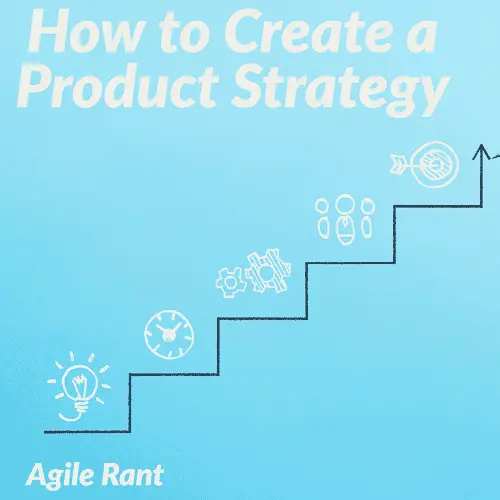How do you create a product strategy? Creating a product strategy is a critical process that defines the vision, goals, and direction for a product. It acts as a roadmap, guiding the product development team to build a successful and marketable product. A well-crafted product strategy aligns business objectives with customer needs and market opportunities.
Steps to Create a Product Strategy:
Market Research and Analysis
Start by conducting comprehensive market research to understand the target market, customer preferences, and industry trends. Gather data on customer demographics, behavior, pain points, and buying habits. Identify product ideas to meet customer needs. Analyze competitors to identify their strengths, weaknesses, and market positioning. This research will form the foundation of your product strategy, ensuring it’s rooted in real market insights, with a solid understanding of the product positioning.
Define Product Vision and Goals
Craft a clear and compelling product vision that defines the purpose and long-term objectives of the product. The vision should inspire and align the entire team behind a common goal. Outline specific and measurable product goals that support the vision. These business goals could include market share targets, revenue projections, customer acquisition, market vision, potential customers or product adoption metrics.
Identify Target Market and Customer Segments
Based on your market research, identify the specific target market and customer segments that your product will cater to. Define buyer personas that represent your ideal customers, including their needs, pain points, motivations, and behaviors. Understanding your target audience is crucial to developing a product that resonates with them. Without understanding target customers, you can’t expect your product to sell.
Value Proposition
Craft a compelling value proposition that clearly communicates the unique value your product offers to customers. Identify the key benefits and advantages that set your product apart from competitors. Your value proposition should address how your product solves customers’ problems, fulfills their needs, or creates new opportunities for them.
Competitive Analysis
Conduct a thorough competitive analysis to identify the strengths and weaknesses of competing products in the market. This analysis helps you understand your product’s positioning and differentiators. Use this information to fine-tune your product strategy and identify opportunities for market differentiation.
Product Roadmap
Develop a product roadmap that outlines the key product initiatives, features, and milestones to achieve the product vision and goals. The roadmap should cover the next 12 to 18 months and should be flexible enough to accommodate changes based on customer feedback and market dynamics. It is a guide to your product efforts.
Prioritization and Resource Allocation
Prioritize the features and initiatives on the product roadmap based on their strategic importance and potential impact on customers and the business. Consider resource constraints, budget limitations, and timeframes when making decisions on what to prioritize. Identify product development teams that can take on the work. Efficient resource allocation is crucial for successful execution.
Go-to-Market Strategy
Outline your go-to-market strategy, which includes the marketing, sales, and distribution plans for your product. Define the target launch date, promotional activities, pricing strategy, and sales channels. Ensure alignment between your product strategy and go-to-market plan to maximize product success.
Metrics and KPIs
Define key performance indicators (KPIs) and metrics to track the success of your product strategy. These metrics could include customer acquisition rate, customer retention rate, revenue growth, market share, customer satisfaction, and more. Regularly measure and analyze these metrics to assess the effectiveness of your product strategy.
Communication and Alignment
Effectively communicate the product strategy across the organization to ensure alignment and buy-in from all stakeholders. Involve cross-functional teams, including marketing, sales, development, and customer support, in the strategy creation process. Continuous communication and collaboration are essential for successful execution.
Customer Feedback and Iteration
Throughout the product development process, gather feedback from customers, both existing and potential. Listen to their needs, pain points, and suggestions for improvement. Incorporate this feedback into your product strategy and roadmap to ensure the product remains customer-centric and relevant.
Regular Review and Adaptation
A product strategy is not set in stone; it should be regularly reviewed and adapted based on changing market conditions, customer feedback, and business goals. Embrace an agile approach to product strategy, where adjustments and iterations are made based on real-time insights.
Why Product Strategy is Key to Building Your Product Successfully
In the ever-evolving landscape of business, where innovation and competition are constant, the role of product strategy stands as a guiding beacon towards success. A well-crafted product strategy serves as a comprehensive guide, steering product teams through the intricacies of development, aligning their efforts with overarching company goals, and helping them navigate the obstacles that inevitably arise along the journey.
In the realm of product development, the path to success is paved with challenges. Teams encounter shifting market dynamics, technological advancements, and changing consumer preferences, all of which can divert their focus and dilute their efforts. This is where a robust product strategy comes into play. It not only provides a roadmap for teams, but also empowers them to overcome obstacles by offering a clear sense of direction. With a unified understanding of the product’s purpose and its role in fulfilling company goals, teams can better maneuver through the complexities that might otherwise derail their progress.
At the heart of every successful product strategy lies a deep understanding of user needs. Delighting customers is the ultimate aspiration, and this can only be achieved when a strategy is built upon a foundation of empathy and insight. By centering the development strategy around user needs, product teams can ensure that the final product resonates with its intended audience, addressing their pain points and fulfilling their desires. This customer-centric approach not only drives engagement and loyalty but also fosters a reputation for delivering meaningful solutions.
Uniting the Team
A carefully crafted product strategy does more than simply guide the product’s development; it unites teams behind a shared vision. In a world where cross-functional collaboration is paramount, a well-defined strategy acts as a rallying point, aligning diverse teams and disciplines toward a common objective. It bridges the gap between design, development, marketing, and sales, allowing each department to understand their role in achieving the overarching company goals. This alignment leads to a harmonious synergy where each team’s efforts reinforce the others, ultimately propelling the product towards success.
In essence, a product strategy is the compass that navigates product teams through a sea of challenges, uncertainties, and opportunities. It is the force that ensures user needs are met, customers are delighted, and company goals are achieved. By providing a clear guide, empowering teams to overcome obstacles, and placing user needs at the forefront, a well-crafted product strategy is undeniably the key to unlocking the doors of product success in today’s competitive business landscape.
Key Product Strategies
In the dynamic world of product development, crafting effective strategies is essential for achieving both customer delight and aligning with overarching company goals. Successful product strategies are like the North Star that guides teams through the complex terrain of innovation, helping them strike the delicate balance between user needs and business objectives.
One of the foundational pillars of a sound product strategy is a deep understanding of user needs. It all begins with recognizing the pain points, desires, and aspirations of your target audience. By comprehending these intrinsic motivations, product teams can design solutions that not only meet but exceed user expectations, leading to true customer delight. This customer-centric approach not only ensures a higher level of engagement but also establishes a long-lasting bond with the users.
Effective Development Strategy
An effective development strategy is another crucial facet of product success. It involves the meticulous orchestration of product features and enhancements to achieve product-market fit. This delicate dance requires careful consideration of how each feature contributes to fulfilling user needs while advancing the company’s broader goals. Feature prioritization is the art of discerning which functionalities have the most significant impact on user satisfaction and aligning them with the overall development roadmap.
In a competitive landscape, product strategies can often be categorized into four distinct archetypes: leader, challenger, niche, and cost. A leader strategy involves creating a product that stands at the forefront of the market, setting trends and capturing a dominant position. A challenger strategy focuses on offering an improved product experience compared to the market leader, positioning itself as a compelling alternative. A niche strategy tailors the product to cater specifically to a well-defined segment of the market, often achieving a dedicated following. Lastly, a cost strategy emphasizes affordability as a unique selling proposition, attracting budget-conscious customers.
Ultimately, a successful product strategy is the culmination of meticulous planning, thorough market analysis, and an unyielding commitment to both user needs and company goals. It is the roadmap that bridges the gap between innovation and execution, guiding product teams towards a destination of customer delight, market relevance, and business success.
Create a Product Strategy – in Conclusion
In conclusion, creating a product strategy is a comprehensive process that requires thorough research, strategic thinking, and alignment with customer needs and market opportunities. By following these key steps, you can develop an effective product strategy that drives product success, customer satisfaction, and business growth.
A great read from Shopify on How to Build an Efficient Product Strategy.. Or a great read from Hotjar on Product Strategy.
How to streamline your product management tools Tips for effective collaboration between product managers and engineers How do product managers work with other teams?
Source: aha.io
Get your copy A ready-to-use product strategy template Being a good product manager means championing the voice of the customer while advancing broader business goals.
Source: productboard.com


